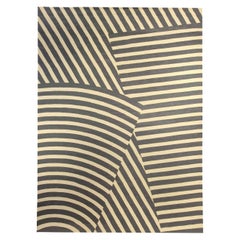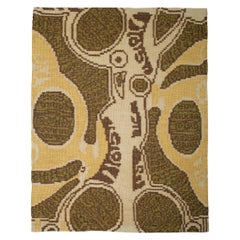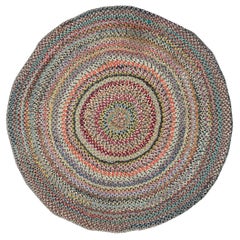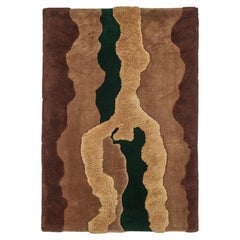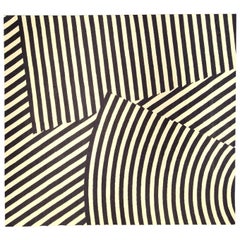Kim Alexandriuk North and South American Rugs
to
Width
to
Length
to
3
3
3
3
3
3
3
3
3
3
3
3
3
63
63
46
45
Creator: Kim Alexandriuk
Contemporary Berber Hills Handmade Wool by Kim Alexandriuk for Doris Leslie Blau
By Kim Alexandriuk
Located in New York, NY
Contemporary Berber Hills handmade wool by Kim Alexandriuk for Doris Leslie Blau.
Size: 11'5" × 15'8" (347 × 477 cm).
Kim Alexandriuk was raised in Germany and got her education in f...
Category
21st Century and Contemporary Indian Modern Kim Alexandriuk North and South American Rugs
Materials
Wool
Contemporary Tattoo Rug by Kim Alexandriuk for Doris Leslie Blau
By Kim Alexandriuk
Located in New York, NY
Contemporary tattoo rug by Kim Alexandriuk for Doris Leslie Blau.
Size: 10'0" × 13'8" (304 × 416 cm).
Kim Alexandriuk evokes traditional tribal patterns but assembles them with a mor...
Category
21st Century and Contemporary Indian Modern Kim Alexandriuk North and South American Rugs
Materials
Wool
Kim Alexandriuk Tattoo Relief Hand Knotted Wool Rug for Doris Leslie Blau
By Kim Alexandriuk
Located in New York, NY
Kim Alexandriuk Tattoo Relief Hand Knotted Wool Rug for Doris Leslie Blau
Size: 8'0" x 10'0" (243 x 304 cm)
Thanks to bold rugs you can find new ways of making interiors brighter and...
Category
21st Century and Contemporary Indian Modern Kim Alexandriuk North and South American Rugs
Materials
Wool
Related Items
Mid-20th Century Handmade American Braided Round / Circular Accent Carpet
Located in New York, NY
A vintage American Braid round/circular accent rug handmade during the mid-20th century.
Measures: 7' 1" x 7' 1".
Category
Mid-20th Century American American Classical Kim Alexandriuk North and South American Rugs
Materials
Wool, Yarn
Edward Fields Hand Knotted Tapestry Rug
By Edward Fields
Located in Los Angeles, CA
Edward Fields rug or tapestry, c.1970s, USA. This hand knotted wool rug features varying pile heights that add depth and texture to the piece. Its color ranges in tones of brown, car...
Category
1970s American Mid-Century Modern Vintage Kim Alexandriuk North and South American Rugs
Materials
Wool
LA 000 Brazilian Contemporary Rug by Lattoog
Located in Sao Paolo, BR
Following the concept of design-fusion, created by the Lattoogs around 2004, the PAULIOCA series was born. The fusion of the urban icons of two big cities – Rio and São Paulo – gener...
Category
21st Century and Contemporary Brazilian Kim Alexandriuk North and South American Rugs
Materials
Tapestry, Nylon
Mid-20th Century Handmade American Rag Rug
Located in New York, NY
A vintage American rag rug handmade during the mid-20th century.
Measures: 3' 6" x 5' 8"
North American rugs & carpets:
North American has never developed a unified handmade rug tradition, but rather it is the unassimilated confluence of several. From Mexico comes the Saltillo serape wearing blanket, and this stimulates the Navajo and Rio Grande (Colorado) weavers, first as blankets, then as rugs. The thrifty habits of rural America gave rise to the New England (and Western Canadian) hooked rug types, while the farmers of the Midwest recycled their disused garments into braided and rag rugs.
The closest to a real ongoing tradition are the Southwestern (New Mexican) Navajo rugs. By the 1860s the native tribes were weaving wearing blankets with wool from the Spanish churro sheep. These were in stripe design, with combinations of undyed wool with cochineal reds and indigo blues. The multi-phase “Chief’s Blankets” from the 1870s-80s are a natural outgrowth of these. Machine spun red wool from Germantown in Pennsylvania appeared in the 1870s with a bright red hitherto unobtainable. The weavers loved it and blankets appeared with bright reds, generally aniline, in “eye dazzler” patterns. Anglo traders established posts beginning in the 1890s. Navajo weavings were perfect accompaniments not only for Western-themed decors, but for East Coast apartments, only they needed to be thicker and more rug like to be truly accepted. The traders brought Caucasian and Turkish village rugs to copy, borders were introduced and central medallions devised. The weavers continued to create on vertical looms, with a shared warp (dovetailing) weft structure to avoid slits. The warps were cotton string. Sizes were generally scatters, but occasionally a special order came in, hence antique room size Navajos are very rare and very pricey. Distinct village/pueblo styles developed. Among the best are: Two Grey Hills (considered the tightest, closest of all Navajo weaving), Crystal Springs, and Ganado. Certain new patterns such as the “Storm pattern” with jagged lightning bolts emanating from a dark cloud developed. The Yei rug with dancing Kachina doll figures became popular. The palette has been expanded beyond the classic grey, tan, dark brown, and cream natural wool combination to again include reds, blues, and greens. Navajo pictorials include American flags, trains, and automobiles, domestic and local scenes and scenery. Individual artist weavers now command gallery shows and correspondingly elevated prices. There are several levels of Navajo work, and antique and vintage scatters with simple flat designs, medium weaves, and tritonal palettes, and in good floor worthy condition are still available reasonably.
The Native American weaving tradition extends into Colorado with two-piece scatters with sharp sawtooth medallions and striped end borders, with wool tapestry weave on cotton warps. These descend from the Saltillo blankets...
Category
Mid-20th Century American Folk Art Kim Alexandriuk North and South American Rugs
Materials
Wool, Cotton, Yarn
Oval Mid-20th Century Handmade American Braided Room Size Carpet
Located in New York, NY
A vintage American Braided oval room size carpet handmade during the mid-20th century.
Measures: 9' 5" x 12' 3"
North American has never developed a unified handmade rug tradition, but rather it is the unassimilated confluence of several. From Mexico comes the Saltillo serape wearing blanket, and this stimulates the Navajo and Rio Grande (Colorado) weavers, first as blankets, then as rugs. The thrifty habits of rural America gave rise to the New England (and Western Canadian) hooked rug types, while the farmers of the Midwest recycled their disused garments into braided and rag rugs.
The closest to a real ongoing tradition are the Southwestern (New Mexican) Navajo rugs. By the 1860’s the native tribes were weaving wearing blankets with wool from the Spanish churro sheep. These were in stripe design, with combinations of undyed wool with cochineal reds and indigo blues. The multi-phase “Chief’s Blankets” from the 1870’s-80’s are a natural outgrowth of these. Machine spun red wool from Germantown in Pennsylvania appeared in the 1870’s with a bright red hitherto unobtainable. The weavers loved it and blankets appeared with bright reds, generally aniline, in “eye dazzler” patterns. Anglo traders established posts beginning in the 1890’s. Navajo weavings were perfect accompaniments not only for Western-themed decors, but for East Coast apartments, only they needed to be thicker and more rug like to be truly accepted. The traders brought Caucasian and Turkish village rugs to copy, borders were introduced and central medallions devised. The weavers continued to create on vertical looms, with a shared warp (dovetailing) weft structure to avoid slits. The warps were cotton string. Sizes were generally scatters, but occasionally a special order came in, hence antique room size Navajos are very rare and very pricey. Distinct village/pueblo styles developed. Among the best are: Two Grey Hills (considered the tightest, closest of all Navajo weaving), Crystal Springs and Ganado. Certain new patterns such as the “Storm pattern” with jagged lightning bolts emanating from a dark cloud developed. The Yei rug with dancing Kachina doll figures became popular. The palette has been expanded beyond the classic grey, tan, dark brown and cream natural wool combination to again include reds, blue and greens. Navajo pictorials include: American flags, trains and automobiles, domestic and local scenes and scenery. Individual artist weavers now command gallery shows and correspondingly elevated prices. There are several levels of Navajo work, and antique and vintage scatters with simple flat designs, medium weaves and tritonal palettes, and in good floor worthy condition are still available reasonably.
The Native American weaving tradition extends into Colorado with two piece scatters with sharp sawtooth medallions and striped end borders, with wool tapestry weave on cotton warps. These descend from the Saltillo blankets...
Category
Mid-20th Century American American Classical Kim Alexandriuk North and South American Rugs
Materials
Wool, Yarn
$3,900 Sale Price
20% Off
W 113 in L 147 in
Antique Two Grey Hills-Inspired Southwest Modern Rug Early 20th Century
By Navajo
Located in Dallas, TX
79135 Antique Two Grey Hills Southwestern style Kilim Rug, 04'05 x 07'01. This handwoven wool antique Two Grey Hills Southwestern style kilim represents the pinnacle of Southwestern ...
Category
Early 20th Century American Spanish Colonial Kim Alexandriuk North and South American Rugs
Materials
Wool
Contemporary Handmade Moroccan Berber Rug. 100% Wool. Custom Options Available
Located in Spring Valley, NY
A contemporary hand-knotted Moroccan rug inspired by the Berber culture in the Atlas Mountains, with soft, lush, velvety pile, made of hand-spun natural lambswool. The rug features a...
Category
21st Century and Contemporary Moroccan Modern Kim Alexandriuk North and South American Rugs
Materials
Wool
$2,190 Sale Price / item
40% Off
W 96.46 in L 120.08 in
1930's Earth-Tone Two Grey Hills-Inspired Pillow, Timeless Artisan Luxury
By Navajo
Located in Dallas, TX
78666 Vintage Two Grey Hills-Inspired Pillow Timeless Artisan Luxury in Earth-Toned Geometry, 01'03 x 01'05. A jewel of Southwestern textile design, this handwoven wool accent pillo...
Category
Early 20th Century American Spanish Colonial Kim Alexandriuk North and South American Rugs
Materials
Wool
$439 Sale Price
20% Off
W 15 in L 17 in
Antique Brown Grey Hills Southwestern style Rug Carpet, Native American Textile
By Navajo
Located in Dallas, TX
78748 Antique Two Grey Hills Southwestern Style Kilim, 02'03 x 02'10. Two Grey Hills Southwestern style kilims, originating from the region historically associated with this iconic w...
Category
Early 20th Century American Aesthetic Movement Kim Alexandriuk North and South American Rugs
Materials
Wool
$2,639 Sale Price
20% Off
W 27 in L 34 in
Rug & Kilim’s Contemporary Cowhide Rug in White and Beige-Brown
By Rug & Kilim
Located in Long Island City, NY
A 7x7 from Rug & Kilim’s line of handmade cowhide rugs. Enjoying a silky, lustrous sheen complementing the pallet of white and brown with cream accents. A comfortable, textural choic...
Category
2010s Brazilian Modern Kim Alexandriuk North and South American Rugs
Materials
Leather
1980's Rio Grande Banded Blanket Rug with Southwest Modern Style by Tierra Wools
By Navajo
Located in Dallas, TX
78795 Vintage Rio Grande Tierra Wools Rug, 03'00 x 05'03. This handwoven wool vintage Tierra Wools rug, crafted in Los Ojos, New Mexico by acclaimed weaver Louisa Ulibarri, is a rare...
Category
Late 20th Century American Spanish Colonial Kim Alexandriuk North and South American Rugs
Materials
Wool
$1,119 Sale Price
25% Off
W 36 in L 63 in
Alexander McQueen Military Brocade Palatial Silk on Wool Hand-Knotted Rug, 2012
By Alexander McQueen, The Rug Company
Located in Brooklyn, NY
Alexander McQueen Military Brocade Palatial Rug, Gold, Ivory, Silk, Wool, 2012. Extremely rare 18’7” x 12’ size. Limited edition gold on ivo...
Category
21st Century and Contemporary Nepalese Organic Modern Kim Alexandriuk North and South American Rugs
Materials
Wool, Silk
$54,720 Sale Price
20% Off
W 144 in L 223 in
Previously Available Items
21st Century Abstract Berber Hills Black and White Wool Rug by Kim Alexandriuk
By Kim Alexandriuk
Located in New York, NY
21st century abstract Berber hills black and white wool rug by Kim Alexandriuk
Size: 8'0" x 10'0" (243 x 304 cm)
Abstraction is one of the most revolutionary trends in art which st...
Category
21st Century and Contemporary Indian Modern Kim Alexandriuk North and South American Rugs
Materials
Wool
Kim Alexandriuk north and south american rugs for sale on 1stDibs.
Kim Alexandriuk north and south american rugs are available for sale on 1stDibs. These distinctive items are frequently made of wool and are designed with extraordinary care. Many of the original north and south american rugs by Kim Alexandriuk were created in the modern style in asia during the 21st century and contemporary. If you’re looking for additional options, many customers also consider north and south american rugs by Pieces, and Eskayel. Prices for Kim Alexandriuk north and south american rugs can differ depending upon size, time period and other attributes — on 1stDibs, these items begin at $8,500 and can go as high as $16,000, while a piece like these, on average, fetch $12,500.
